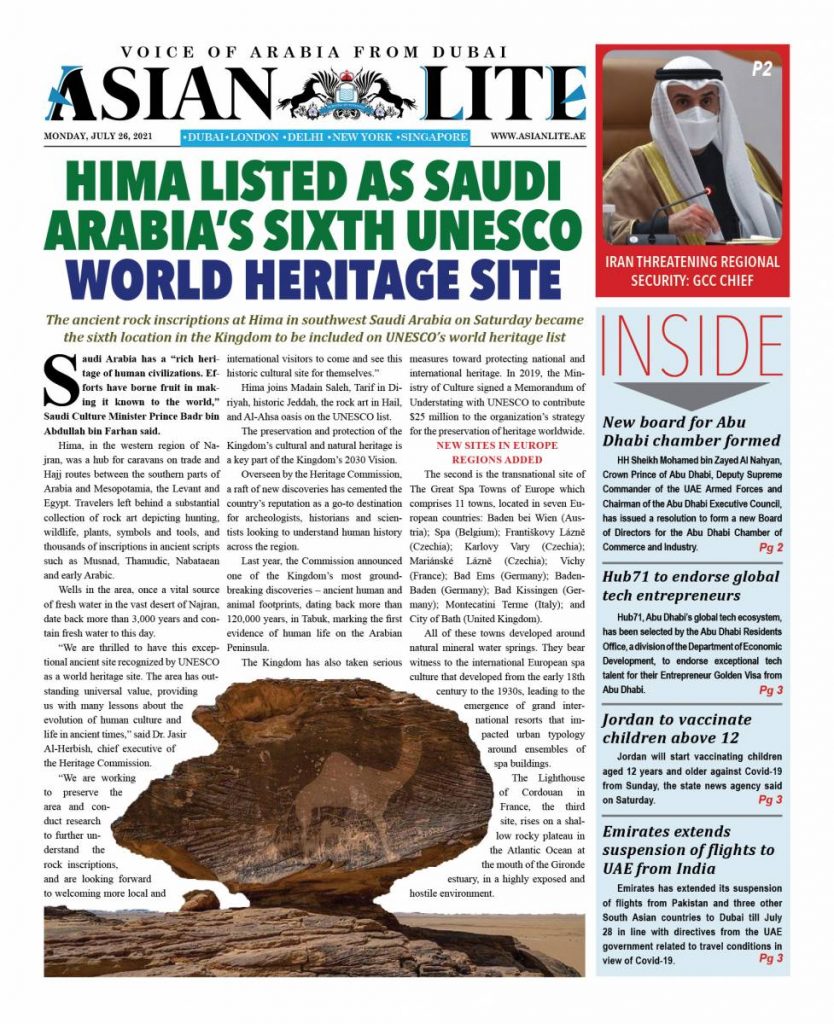Hima joins Madain Saleh, Tarif in Diriyah, historic Jeddah, the rock art in Hail, and Al-Ahsa oasis on the UNESCO list….reports Asian Lite News
The ancient rock inscriptions at Hima in southwest Saudi Arabia on Saturday became the sixth location in the Kingdom to be included on UNESCO’s world heritage list.
Saudi Arabia has a “rich heritage of human civilizations. Efforts have borne fruit in making it known to the world,” Saudi Culture Minister Prince Badr bin Abdullah bin Farhan said.
Hima, in the western region of Najran, was a hub for caravans on trade and Hajj routes between the southern parts of Arabia and Mesopotamia, the Levant and Egypt. Travelers left behind a substantial collection of rock art depicting hunting, wildlife, plants, symbols and tools, and thousands of inscriptions in ancient scripts such as Musnad, Thamudic, Nabataean and early Arabic.
Wells in the area, once a vital source of fresh water in the vast desert of Najran, date back more than 3,000 years and contain fresh water to this day.
“We are thrilled to have this exceptional ancient site recognized by UNESCO as a world heritage site. The area has outstanding universal value, providing us with many lessons about the evolution of human culture and life in ancient times,” said Dr. Jasir Al-Herbish, chief executive of the Heritage Commission.
“We are working to preserve the area and conduct research to further understand the rock inscriptions, and are looking forward to welcoming more local and international visitors to come and see this historic cultural site for themselves.”
Hima joins Madain Saleh, Tarif in Diriyah, historic Jeddah, the rock art in Hail, and Al-Ahsa oasis on the UNESCO list.
The preservation and protection of the Kingdom’s cultural and natural heritage is a key part of the Kingdom’s 2030 Vision.
Overseen by the Heritage Commission, a raft of new discoveries has cemented the country’s reputation as a go-to destination for archeologists, historians and scientists looking to understand human history across the region.
Last year, the Commission announced one of the Kingdom’s most ground-breaking discoveries – ancient human and animal footprints, dating back more than 120,000 years, in Tabuk, marking the first evidence of human life on the Arabian Peninsula.
The Kingdom has also taken serious measures toward protecting national and international heritage. In 2019, the Ministry of Culture signed a Memorandum of Understating with UNESCO to contribute $25 million to the organization’s strategy for the preservation of heritage worldwide.

New sites in Europe regions added
The second is the transnational site of The Great Spa Towns of Europe which comprises 11 towns, located in seven European countries: Baden bei Wien (Austria); Spa (Belgium); Františkovy Lázně (Czechia); Karlovy Vary (Czechia); Mariánské Lázně (Czechia); Vichy (France); Bad Ems (Germany); Baden-Baden (Germany); Bad Kissingen (Germany); Montecatini Terme (Italy); and City of Bath (United Kingdom).
All of these towns developed around natural mineral water springs. They bear witness to the international European spa culture that developed from the early 18th century to the 1930s, leading to the emergence of grand international resorts that impacted urban typology around ensembles of spa buildings.
The Lighthouse of Cordouan in France, the third site, rises on a shallow rocky plateau in the Atlantic Ocean at the mouth of the Gironde estuary, in a highly exposed and hostile environment. Built-in white limestone dressed blocks at the turn of the 16th and 17th centuries, it was designed by engineer Louis de Foix and remodelled by engineer Joseph Teulère in the late 18th century. It embodies the great stages of the architectural and technological history of lighthouses and was built with the ambition of continuing the tradition of famous beacons of antiquity, illustrating the art of building lighthouses in a period of renewed navigation when beacons played an important role as territorial markers and as instruments of safety.
The fourth is the Darmstadt Artists’ Colony on Mathildenhöhe in Germany, the highest elevation above the city of Darmstadt in west-central Germany, which was established in 1897 by Ernst Ludwig, Grand Duke of Hesse, as a centre for emerging reform movements in architecture, arts and crafts. The buildings of the colony were created by its artist members as experimental early modernist living and working environments. The colony was expanded during successive international exhibitions in 1901, 1904, 1908 and 1914.
Lastly Padua’s fourteenth-century fresco cycles in Italy. The site is composed of eight religious and secular building complexes, within the historic walled city of Padua, which house a selection of fresco cycles painted between 1302 and 1397 by different artists for different types of patron and within buildings of diverse functions.














